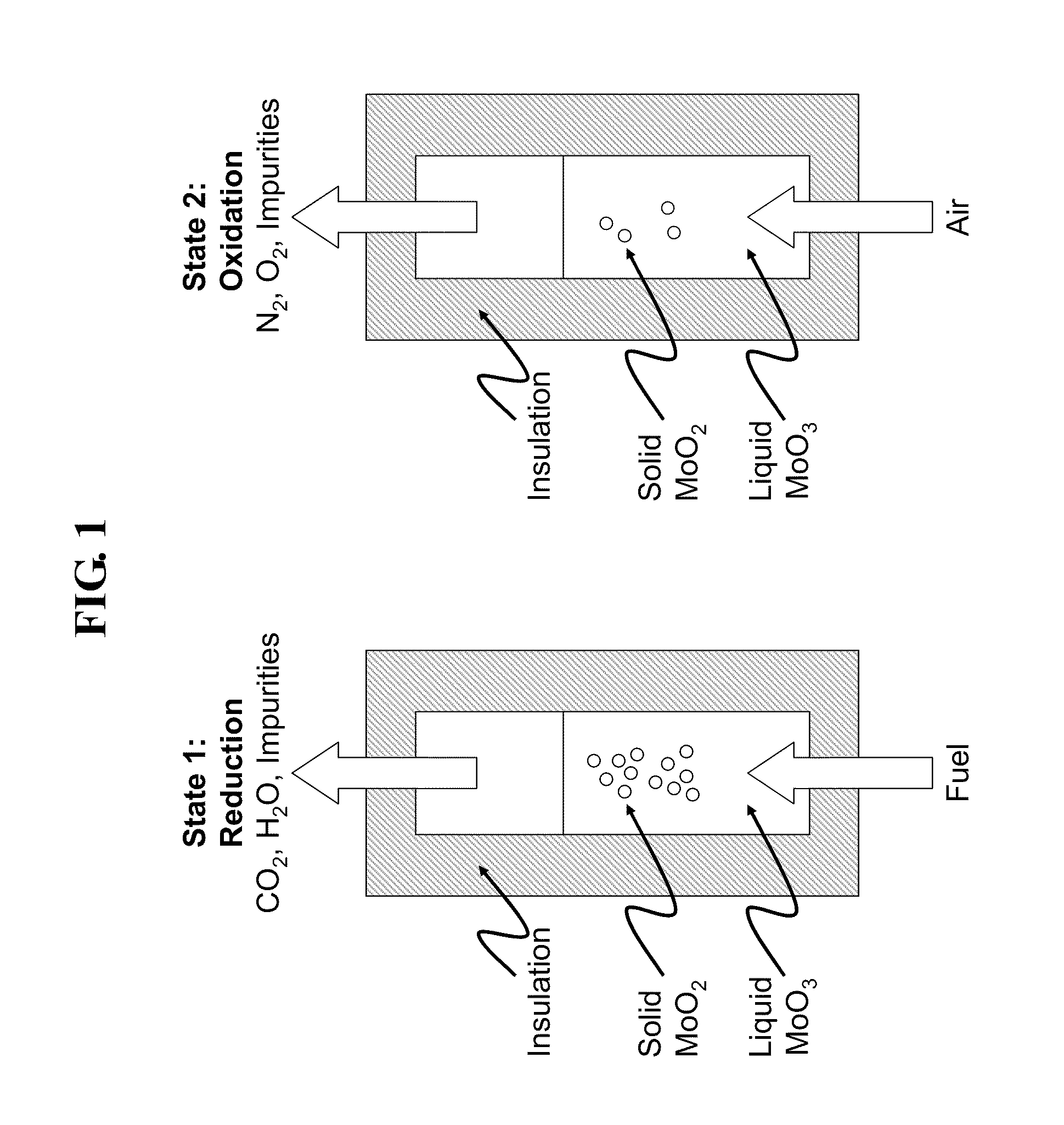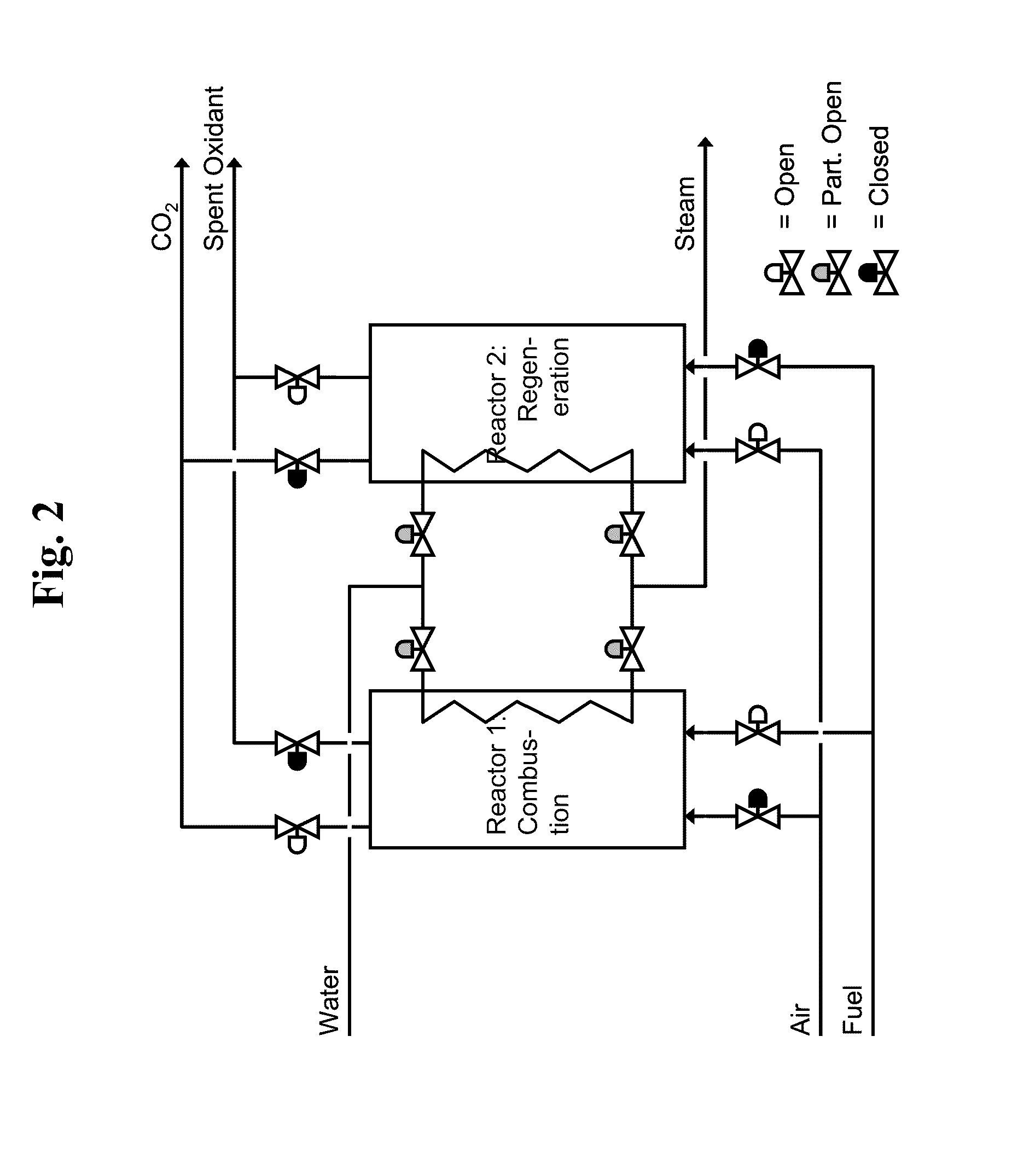Liquid-phase chemical looping energy generator
a technology of energy generator and liquid phase, which is applied in the direction of arsenic compounds, lighting and heating apparatus, gas-gas reaction processes, etc., can solve the problems of reducing the overall combustion efficiency of the step, generating or consuming heat, and releasing hea
- Summary
- Abstract
- Description
- Claims
- Application Information
AI Technical Summary
Benefits of technology
Problems solved by technology
Method used
Image
Examples
example 1
Molybdenum Oxide Reaction
[0023]In one embodiment a desirable metal oxide would be MoO3. MoO3 has a sufficiently low melting point of approximately 795° C. that conventional reactor materials with standard construction and care may be used to contain the reaction. Assuming the carbonaceous fuel to be pure carbon, the reaction chemistry is as follows:
TABLE 2Molybdenum Oxide CLC reactionsRxn. TypeRxn. StoichiometryStd. Rxn. EnthalpyFuel Oxidation2 MoO3 + C = 2 MoO2 + CO2 −82.9 MJ / mol carbonOxide2MoO2 + O2 = 2 MoO3−310.6 MJ / mol O2RegenerationNetC + O2 = CO2−393.5 MJ / mol
[0024]A reactor contains a pool of molten MoO3 in direct or indirect thermal contact with a closed-loop steam system and a heat recovery system to recover useful heat from the exiting exhaust and regeneration gas streams. In addition, the reactor would also be in contact with a CO2 capture system that captures and prepares the CO2 released from fuel combustion with MoO3 for disposal. The reactor would ideally be operated ...
example 2
Blended Metal Oxides
[0025]Metal oxides including molybdenum, vanadium, manganese, copper, and bismuth oxides may be blended. These metal oxides may also be blended with other oxides such as boric oxide, lime and other materials, to change the overall melt temperature, change the upper or lower temperatures of the reaction, and generally to obtain desirable properties of the bulk melt. Refractory materials for the reaction chamber are widely available and include materials such as silicon carbide, chromia, alumina, magnesia, dolomite or combinations. An extensive, but not exhaustive, list of metal oxides that are useful for the refractory, melt, or as a oxide catalyst are listed in Table 3. More strongly ionic species such as nitrate, phosphate, silicate and sulfate metallic salts, are not shown, but could also be used in varying amounts in the melt.
TABLE 3Metal SpeciesMeltingMeltingPointPrimaryMetalPoint[° C.]UseOxide[° C.]Primary UseGroup IALi186n / aLi2O1,570MeltNa98n / aNa2O1,132Melt...
PUM
| Property | Measurement | Unit |
|---|---|---|
| melting point | aaaaa | aaaaa |
| combustion efficiency | aaaaa | aaaaa |
| electrical | aaaaa | aaaaa |
Abstract
Description
Claims
Application Information
 Login to View More
Login to View More - R&D
- Intellectual Property
- Life Sciences
- Materials
- Tech Scout
- Unparalleled Data Quality
- Higher Quality Content
- 60% Fewer Hallucinations
Browse by: Latest US Patents, China's latest patents, Technical Efficacy Thesaurus, Application Domain, Technology Topic, Popular Technical Reports.
© 2025 PatSnap. All rights reserved.Legal|Privacy policy|Modern Slavery Act Transparency Statement|Sitemap|About US| Contact US: help@patsnap.com



